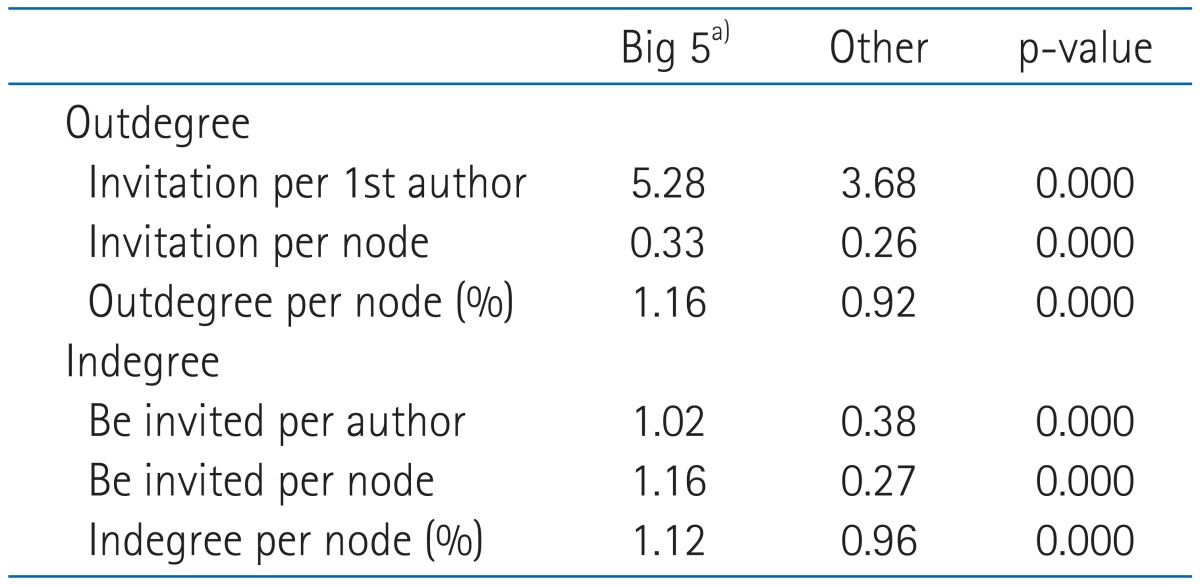Co-authorship patterns and networks of Korean radiation oncologists
Article information
Abstract
Purpose
This research aimed to analyze the patterns of co-authorship network among the Korean radiation oncologists and to identify attributing factors for the formation of networks.
Materials and Methods
A total of 1,447 articles including contents of 'Radiation Oncology' and 'Therapeutic Radiology' were searched from the KoreaMed database. The co-authorship was assorted by the author's full name, affiliation and specialties. UCINET 6.0 was used to figure out the author's network centrality and the cluster analysis, and KeyPlayer 1.44 program was used to get a result of key player index. Sociogram was analyzed with the Netdraw 2.090. The statistical comparison was performed by a t-test and ANOVA using SPSS 16.0 with p-value < 0.05 as the significant value.
Results
The number of articles written by a radiation oncologist as the first author was 1,025 out of 1,447. The pattern of co-authorship was classified into five groups. For articles of which the first author was a radiation oncologist, the number of single-author articles (type-A) was 81; single-institution articles (type-B) was 687; and multiple-author articles (type-C) was 257. For the articles which radiation oncologists participated in as a co-author, the number of single-institution articles (type-D) was 280 while multiple-institution articles (type-E) were 142. There were 8,895 authors from 1,366 co-authored articles, thus the average number of authors per article was 6.51. It was 5.73 for type-B, 6.44 for type-C, 7.90 for type-D, and 7.67 for type-E (p = 0.000) in the average number of authors per article. The number of authors for articles from the hospitals published more than 100 articles was 7.23 while form others was 5.94 (p = 0.005). Its number was 5.94 and 7.16 for the articles published before and after 2001 (p = 0.000). The articles written by a radiation oncologist as the first author had 5.92 authors while others for 7.82 (p = 0.025). Its number was 5.57 and 7.71 for the Journal of the Korean Society for Therapeutic Radiology and Oncology and others (p = 0.000), respectively. Among the analysis, a significant difference in the average number of author per article was indicated. The out-degree centrality of network among authors was 4.26% (2.03.7.09%) while in-degree centrality was 1.31% (0.53.2.84%). The three significant nodes were classified and listed as following: Choi, Eun Kyung for 1991-1995, Kim, Dae Young for 1998-2001, Park, Won and Lee, Sang Wook for 2003-2010. Choi, Eun Kyung and Kim, Dae Young appeared in two cases, and ranked as the highest degree in centrality. In the key player analysis, Choi, Eun Kyung and Lee, Sang Wook appeared in two cases, and ranked as the highest. From the cluster analysis, Sungkyunkwan University, Seoul National University and Yonsei University revealed as the three large clusters when Ulsan University, Chonnam National University, and Korea Institute of Radiological & Medical Science as the medium clusters.
Conclusion
The Korean radiation oncologist's society shows a closed network with numerous relationships among the particular clusters, and the result indicates it is different from other institutions in the pattern of co-authorship formation of the major hospitals.
Introduction
In general, network is defined as a method of sharing information with somebody else. This method commonly has a complex spider-web pattern complicated with the vast social relationship. Moreover, ranges of network are enormous since all the categories including different communicating objects are able to be handled by a network. Consequently, the medical knowledge forms a network when a mutual relationship is induced by the constant connection and the share of its information among the medical scientists. An academic network of scholars is expressed as sharing the final products of publications throughout the co-author relationship. We believe an analysis of co-authorship is as an effective way to figure out a pattern of scientific collaboration.
In our previous research, the structural characteristic of Radiation Oncology institutions in Korea was analyzed in order to suggest more effective collaborative system [1]. The various patters, however, would be appeared depending on an author's purpose of co-authorship and the level of comprehension when a network is formed within or between institutions. In the perspective of a researcher, each author's status in Radiation Oncology is required to understand the characteristics of the network profoundly. With this reason, this study is aimed to understand the pattern of network formation and the characteristics of network among authors using a social network and standard statistical analysis of co-authored journals in the Korean Radiation Oncology. Henceforth, it can be applied as the basic data to bring development into the Radiation Oncology society. We believe these studies are able to propose a long-term strategy how the research collaboration progresses in the Radiation Oncology, and be used as a tool to evaluate it. Also, it can suggest the collaborating research plan throughout observing the system of knowledge production in the field of Radiation Oncology.
Materials and Methods
1. Co-authorship analysis
We found a total of 1,447 articles and 8,976 full author names from the KoreaMed database with the following condition; at lease one's affiliation from authors was in either "Radiation Oncology" or "Therapeutic Radiology," and their journals published in Korea between 1991 and 2010. In this study, we excluded the journals published before 1990 since most of it tended to have incorrect inscriptions in author's affiliation. The journals were classified into three groups: "Journal of Korean Society for Therapeutic Radiology and Oncology," "Korean Journal of Medical Physics (KJMP)," and "Others." The number of journals of which the first author was in Radiation Oncology was 1,025 composed of 70.8% (Table 1). Because KoreaMed database does not specify a corresponding author, the first author and his/her institution were assumed as the main author and institution in the research. The classifying method of the author's institution was performed identically as the previous research had been [1].
2. Network analysis
We used a social network analysis software, UCINET for windows ver. 6 (Analytic Technologies, Lexington, KY, USA) in order to measure centrality indices. A sociogram was performed by a program, Netdraw ver. 2.090 (Analytic Technologies). The degree centrality, closeness centrality, and betweenness centrality were obtained, and compared to indicate the structural properties of a network and an author's status in the network of research institutions. An optimal set of nodes, maintaining and composing a network, was identified by a program, KeyPlayer ver. 1.44 (Analytic Technologies). In this study, distance weighted reach criterion method (KPP-NEG) was used to analyze a key player. This program was designed to designate a node as a key player of which its connectivity drops dramatically or fragmentizes in the case of random elimination of a key node [2]. For the cluster analysis, a clique analysis of UCINET was conducted, and the minimum size was fixed at the value of 1.
Results
We classified the co-authorship patterns, and the results are listed as following; the number of type-A, single-author articles with the first author whose affiliation was a radiation oncologist, was 81; type-B, single-institution articles with the same condition of first author, was 687; type-C, multiple-institution articles with the same condition, was 257; type-D, single-institution articles collaborated with a radiation oncologist, was 280; and type-E, multiple-institutions articles with a collaboration, was 142. Except for the type-A, there was a total 1,366 co-authored articles and 8,898 participated authors, thus 6.51 co-authors per article in average were calculated (Table 1).
Except for the type-A articles, Table 2 shows the number of authors per article; 5.73 for type-B, 6.44 for type-C, 7.90 for type-D, and 7.67 for type-E (p = 0.000) (Fig. 1). The number of authors for articles from the hospitals published more than 100 articles was 7.23 while form others was 5.94 (p = 0.005). Its number was 5.94 and 7.16 for the articles published before and after 2001 (p = 0.000). The articles written by a radiation oncologist as the first author had 5.92 authors while others for 7.82 (p = 0.025). Its number was 5.57 and 7.71 for the Journal of the Korean Society for Therapeutic Radiology and Oncology and others (p = 0.000), respectively. Among the analysis, there was a significant difference in the average number of author per article. According to the types of co-authorship from 1991 to 2010, the changes in its average number clarified the significant difference (Fig. 2). The number of journals type-C, -D, and -E increased since 1997 while the type-B was constant. Consequently, the total number of Radiation Oncology journals was increased as well. While it was 0.21 in the correlation coefficient between numbers of the co-authorship type-B and total articles, it was 0.90, 0.93, and 0.82 for type-C, -D, and -E respectively (p = 0.000). From the research, the five hospitals published more than 100 research articles were Seoul National University, Yonsei University, Catholic University, Ulsan University, and Sungkyunkwan University, and we found a significant difference in the formation of pattern to collaborate with other institutions (Table 3). When other institutions, published less than 100 research papers, had high ratio of type-A, we observed the high ratio of type-B in the case of the five major hospitals. Especially in type-B from the major hospitals, the number of articles published by 7 to 10 authors was remarkably higher than any other institution (Fig. 3).
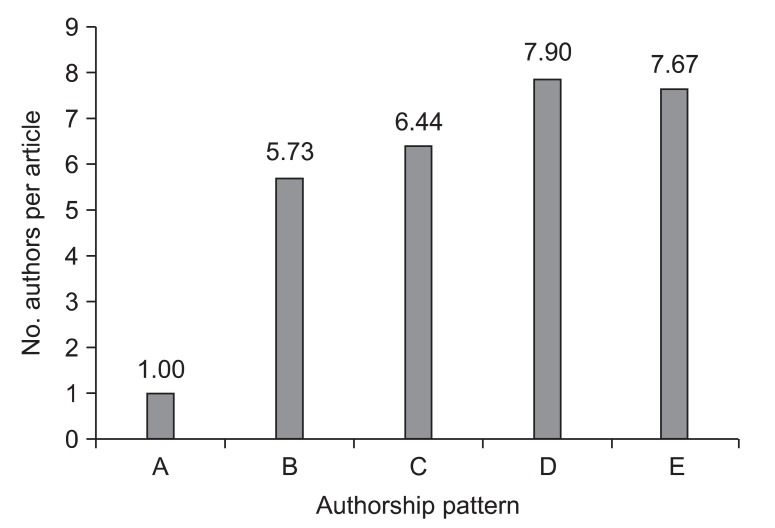
Number authors per article of according to the coauthorship pattern. The result shows that there are significant differences among group B, C, D, and E (p = 0.000). The difference between group B and C was also significant (p = 0.002) but there was no significant difference between group D and E (p = 0.522). A, 1st = radiation oncology (RO) & single author; B, 1st = RO & multiple author & single institution; C, 1st = RO & multiple authors & multiple institutions; D, 1st ≠ RO & multiple authors & single institution; E, 1st ≠ RO & multiple authors & multiple institutions.
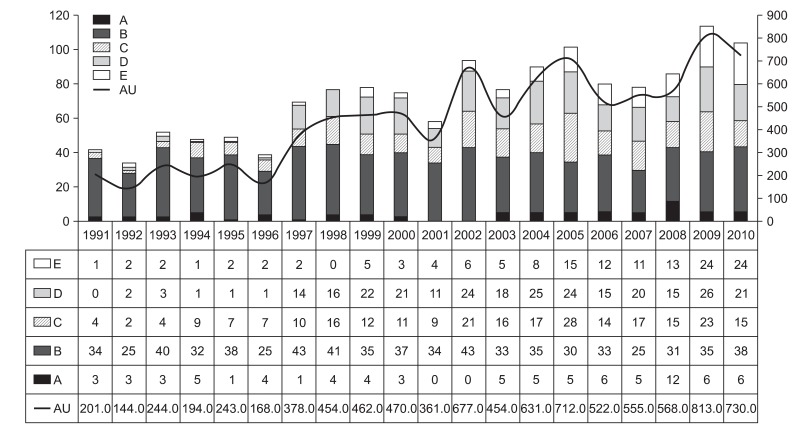
Pattern changes according to the years. In recent 10 years, the number of articles co-authoring with other departments or other institutions are increased. The average number of authors is strongly correlated with the number of group C (0.90), group D (0.93), and group E (0.82) but it is very weakly related with group B (0.21). A, 1st = radiation oncology (RO) & single author; B, 1st = RO & multiple author & single institution; C, 1st = RO & multiple authors & multiple institutions; D, 1st ≠ RO & multiple authors & single institution; E, 1st ≠ RO & multiple authors & multiple institutions.
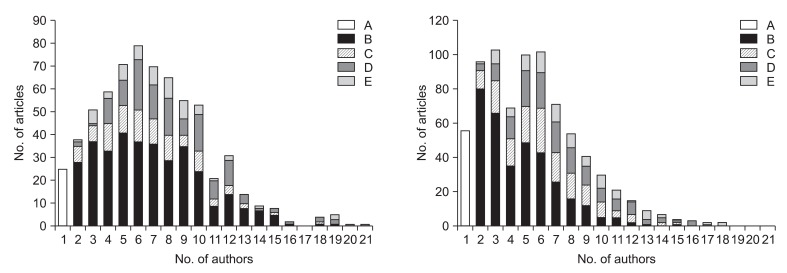
Author distributions according to the co-authorship pattern. Upper big 5, lower other hospitals. Big 5 showed bell shaped Gaussian distribution while the other hospitals showed power law distribution. A, 1st = radiation oncology (RO) & single author; B, 1st = RO & multiple author & single institution; C, 1st = RO & multiple authors & multiple institutions; D, 1st ≠ RO & multiple authors & single institution; E, 1st ≠ RO & multiple authors & multiple institutions.
1. Author's network analysis
For the network analysis, we analyzed 1,351 articles excluding the single-author articles and the journals from KJMP. We excluded KJMP because these journals were published in a short period of time and produced the network too excessively considering its number of articles published [1]. In this research, an author and a co-authorship were defined as a node and a network (Fig. 4). A centrality of the specific node represents the index of centralization degree where a performer is located in a network. The closeness centrality is defined as how a node is close to other nodes. The betweenness centrality shows how a node acts as an intermediary to form a network with other nodes [1]. A centrality can be categorized into an out-degree and an in-degree as well. Basically, an out-degree centrality means the direction of it towards outside, and, in the field of co-authorship, it represents the degree of the first author's tendency to collaborate with co-authors. Likewise, the in-degree centrality means the degree of an author's tendency participated as a co-author. Between 1990 and 2010, the percentage of network out-degree centrality among authors were 4.26% in average (ranges between 2.03 and 7.09%), and the in-degree centrality was 1.31% (range, 0.53 to 2.84%) (Table 4). Choi, Eun Kyung was the major node for the period between 1991 and 1995, Kim, Dae Young was from 1998 to 2001, and Park, won and Lee, Sang Wook were from 2003 to 2010. The author of the highest degree in centrality was Choi, Eun Kyung and Kim, Dae Young who were selected two times. From the key player analysis, Choi, Eun Kyung and Lee, Sang Wook were selected two times, and ranked as the highest degree (Table 4). We found a significant difference in the centralization index between the five major hospitals and others (Table 5). The number of invited cases to be the first author from the major five hospitals, published more than 100 research journals, was 5.28 and relatively higher than other institutions, showed its number as 3.86. Likewise, the case of invited as a co-author had the value of 1.02, and it was higher than others of 0.38. Additionally, it was 1.16% and 1.12% for the out-degree and the in-degree contribution level per node in the major hospitals respectively, which were significantly higher than the one's in other hospitals which had the level of 0.92% and 0.96%.
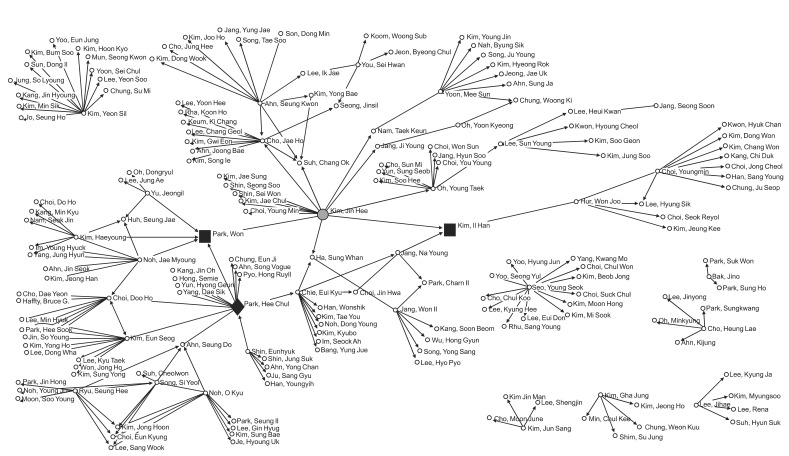
Network diagram in year 2008. Kim, Jin Hee (circle) was highest centrality node. Key player, Park, Won and Kim, Il Han (square) were highest closeness centrality nodes. Park, Hee Chul (diamond) was highest betweenness node.
2. Author's cluster analysis
An author's cluster was performed by a clique analysis of UCINET 6.0. From the analysis, Sungkyunkwan University, Seoul National University, and Yonsei University revealed as the three large clusters when Ulsan University, Chonnam National University, and Korea Institute of Radiological & Medical Science were the medium clusters (Fig. 5). The networks of authors from other institutions were not large enough to form a cluster.
Discussion and Conclusion
The co-authorship network is an interrelationship among scientists who co-published a journal and formed a structure of knowledge system. From the analysis of co-authorship, it is observed dynamically in the pattern of how the knowledge is produced and shared in a society of scientists [3]. The map of science is as important as the quantitative analysis to visualize the structural relationship. We believe the insufficient database is unable to support the national research products, and becomes the major problem of creating a network for the national research trend. Even though the KoreaMed or other institutions provides a service on the national dissertations, the valuable information is not easy to be obtained since the journals initially have inaccurate basic information. Individual researchers have numerous bynames of their affiliations or majors. Also, there is no "data-warehouse" filtering out these bynames, which has caused the problems. Nevertheless, it is possible to extract the data throughout a researcher's own extracting program in limited ranges. We had analyzed the network of SCIE dissertations of 40 medical schools [4] or the institutions in the field of Radiation Oncology in the previous research [1]. Advanced from the previous one, this study aimed to analyze a co-authorship of the articles, published in the last 20 years, in Radiation Oncology to figure out researcher's clusters and its attributing factors.
From the result of this study, we identified the increase in the number of participated authors due to the increase of research size in this academic field. The dramatic difference was also confirmed in the articles collaborated with co-authors whose major was other than Radiation Oncology (type-B). Especially, the major five institutions published more than 100 articles had the significant difference in the participation of co-authorship. The increasing number of authors in an article means the invigoration of research collaboration. On the other hands, it should be noted that an issue of the reliance of author's qualification can be brought. Most of the infrastructure of Radiation Oncology is based on the university or the large research institution. The qualitative evaluation of publications becomes as a research achievement, and influences researcher considerably. Without a doubt, a contribution level of article written by a few authors must be different from the one written by many authors. It is not easy, however, to discriminate the level of contribution of the first author from the co-authors. Moreover, a corresponding author has to be put on weight differently from the others except the first author in the degree of relationship with the first author to reflect clearly the structure of network. Unfortunately, we were not able to conduct this analysis of corresponding author since the KoreaMed did not provide information on them. Also, unlike other clinical researches, the research in the Radiation Oncology is likely to be published with the different perspective of study such as focus on clinic, biology, and physics. In this case, it should be concerned that the number and ranges of participating co-authors are different. With this perspective, we aimed to analyze the characteristic of structure, limited to the pattern and the characteristic of author's network rather than just considering the qualitative evaluation of journals, in order to support the basic database for the better research system. Between 1990 and 2010, the out-degree centrality of authors, tendency involving co-authors, was 4.26% in average (range, 2.03 to 7.09%) and the in-degree centrality was 1.31% (range, 0.53 to 2.84%). It was relatively higher value than other field considering the value is around 0.5% [5] and 0.2% in the national Pathology and the Radiology (unpublished data) respectively. We believed the relatively low number of researchers and their affiliation, limited to a professor at university hospitals, induced the higher frequency of the network compared to others. Especially, the increase of co-authorship between university hospitals (type-B) is related directly to the frequency of network (Figs. 2 and 3). Because of the increase in this co-authorship, the field of Radiation Oncology created "two different kinds of the culture" in the co-authorship pattern. From Fig. 3, a university hospitals' distribution for the number of articles based on the number of authors appeared as a normal distribution, stretched out both side equally when the number of authors are fixed at 6. Otherwise, other hospitals revealed a reversed function distribution due to the increase in the number of authors per article as increasing the number of authors from 2. A similar phenomenon, "the different kinds of the culture", reported from the co-authorship analysis, with 339 articles and 484 authors in the national field of Public Health Administration [3]. From the Journal in which medical health and social scientists work together, the social scientist's preference of co-authorship reported to have the smaller number of authors while the natural scientists prefer the large number. When the number of authors increased, the social scientist's co-authorship decreased accumulatively while the natural scientist's consistently revealed an inverted u-shape with the certain number as a central value. This academic activity could not be only an individual's problem, but also it could be blamed on the influence of social structure or the outcome of the academic field. The co-authorship had to be affected by its research environment, thus the cultures in co-authorship of the Radiation Oncology was different in the large institution from the other hospitals, known as "two different kinds of the culture." There was no appropriate culture, but it ought to be noted that the co-authorship culture of researchers in the Radiation Oncology had different patterns from others.
The researcher in the Radiation Oncology created two different network parts: one connected to the large hospital, called as the main network, and the other with independent institution not connected to the main network group (Fig. 4). From Fig. 4, the co-authorship network in 2008 showed the sociogram, and Kim, Jin Hee was selected 13 times in outdegree centrality occupying 3.403%, and ranked as the highest. It was also designated as a key player from the KeyPlayer program analysis (Fig. 4). Park, Hee Chul was 0.091% in the betweenness centrality, and ranked as the highest. Park, Won and Kim, Il Han were the highest for the closeness centrality. From the example of 2008, there was a network linked by the following pathway as listed: Park, Won - Park, Hee Chul - Chi, Eui Kyu - Jang, na Young - Kim, In Han with Kim, Jin Hee as a center. And, other unconnected independent research groups were also confirmed.
The main network is usually composed of several clusters, and its characteristic can be detected with a clique analysis (Fig. 5). An object has different kinds of attributes, and objects, reflecting a similar characteristic, can be grouped into a cluster by a clique analysis if there are numerous objects. In the field of Radiation Oncology, we found three large clusters: Sungkyunkwan University, Yonsei University and Seoul National University and three medium clusters: Ulsan University, Chonnam National University and Korea Institute of Radiological & Medical Sciences. Not having big enough network size, the other institutions did not form a cluster. A cluster analysis showed the characteristic of each formation of cluster. Usually, 3 to 4 disjoint clusters gathered inside of the large clusters while hierarchical clusters were observed in the medium cluster. For instance, we found the large number of published articles and node in Ulsan University network. However, it revealed a vertical shape of cluster, not containing a similar size of disjoint clusters. The environment also affects the pattern of forming a cluster. The various numbers of disjoint cluster should be observed when co-authors hold their functional status and the narrowed degree of research led by a certain author were low in a network. A hierarchical cluster has advantage of a decision-making process but disadvantage over the diversity on research subjects and the balanced development among researchers. From understanding a characteristic of network, it can establish the strategy or plan on the academic activity of research institution or group. The institution has to decide strategically to choose either a hierarchical or a disjoint cluster.
As a result, the numerous relationships are happened by the certain cluster between researchers in the field of Radiation Oncology in Korea, which is known as a closed characteristic of network. There are different cultures between the large hospitals and others in forming a co-authorship. We assume it can be used to diagnose the present situation of the entire Radiation Oncology and map out a program of development through analyzing compositions of academic co-authorship and network patterns.
Acknowledgments
We are indebted to Mr. Keonhee Kim (the Department of Biochemistry, the University of Texas at Austin, TX, USA) for his engagement in the research. His suggestions and excellent technical supports were greatly helpful to us for the data analysis and the preparation of manuscript. Also, we would like to thank to him his assistance in English translation.
Notes
No potential conflict of interest relevant to this article was reported.



